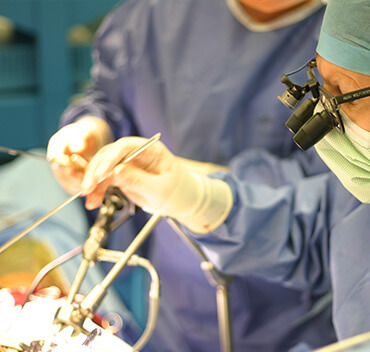Atrial Fibrillation Surgery
 Atrial Fibrillation (AF) is a common condition where the heart’s normal regular rhythm (sinus rhythm) becomes irregularly irregular. The normal rhythm is generated in the inflow chamber (right atrium) to the right heart at what is called the “sinus or sinoatrial or SA node”. This sinus node generates the pulse rate of the heart and varies as body needs vary. Its impulse is transmitted across both left and right atria before crossing at a focal point (atrioventricular or AV node) before spreading in a coordinated manner down the left and right ventricles (the main pumping chambers). This coordinated atrial contraction can wear out with time, or more often be replaced by an irregular rhythm generated from other areas in the inflow chambers (atria). Most commonly this is “Atrial Fibrillation” which often starts from extra beats originating in the veins coming back from the lungs into the left atrium (pulmonary veins). These extra beats can set up conduction pathways that run around in circles instead of in the normal coordinated way. This causes the atria to no longer contract functionally and impairs the filling of the main pumping chambers (left and right ventricles). The highly irregular and fast atrial rhythm is then variably conducted across the AV node resulting in the heart rate varying greatly from very fast to very slow. Medications are usually needed to help slow the heart rate, and sometimes a pacemaker is needed to prevent it going too slow.
Atrial Fibrillation (AF) is a common condition where the heart’s normal regular rhythm (sinus rhythm) becomes irregularly irregular. The normal rhythm is generated in the inflow chamber (right atrium) to the right heart at what is called the “sinus or sinoatrial or SA node”. This sinus node generates the pulse rate of the heart and varies as body needs vary. Its impulse is transmitted across both left and right atria before crossing at a focal point (atrioventricular or AV node) before spreading in a coordinated manner down the left and right ventricles (the main pumping chambers). This coordinated atrial contraction can wear out with time, or more often be replaced by an irregular rhythm generated from other areas in the inflow chambers (atria). Most commonly this is “Atrial Fibrillation” which often starts from extra beats originating in the veins coming back from the lungs into the left atrium (pulmonary veins). These extra beats can set up conduction pathways that run around in circles instead of in the normal coordinated way. This causes the atria to no longer contract functionally and impairs the filling of the main pumping chambers (left and right ventricles). The highly irregular and fast atrial rhythm is then variably conducted across the AV node resulting in the heart rate varying greatly from very fast to very slow. Medications are usually needed to help slow the heart rate, and sometimes a pacemaker is needed to prevent it going too slow.
AF can occur for short periods (Paroxysmal AF) or become permanent (Chronic AF). It can occur by itself (Lone Fibrillation) or be secondary to other cardiac conditions (coronary artery disease, valve disease, cardiomyopathies, obstructive sleep apnea, or lung disease). AF requires medical treatment to control its rate, and sometimes this can also revert it to sinus rhythm. Anticoagulant therapy is also needed to prevent blood clots forming in the dysfunctional atria and then dislodging into the blood flow and causing strokes or damaging other organs of the body.
AF can be corrected to a variable degree by creating an electrical “maze” within the atrial walls that does not allow room for the circular current of AF to form. This can be done as an isolated catheter-based procedure, or as part of cardiac surgery often being performed for associated conditions, most commonly valve surgery. These techniques use heat or cold to create lines in the atrial wall that do not let the electrical current to cross. This is done in a pattern, or maze, that results in one pathway from the SA node to the AV node with not enough room for circular currents of AF to form. AF is a complex pathology so no therapy can always work. Surgical maze can be successful in around 60-80% of chronic AF and as high as 90% in paroxysmal AF. It also involves removal of the atrial appendage, which is the outpouching of the left atrial wall where most documented clots form which can cause strokes. Its surgical removal can help minimise stroke risk.
Establishment of normal heart rhythm long term can allow stopping of anticoagulant medications in many. This is a complex area that you should discuss with your surgeon and cardiologist.




